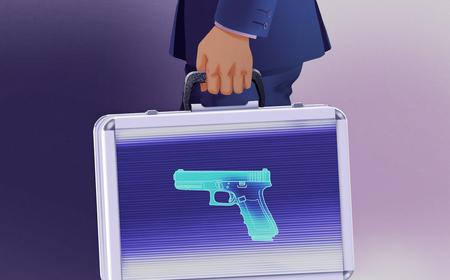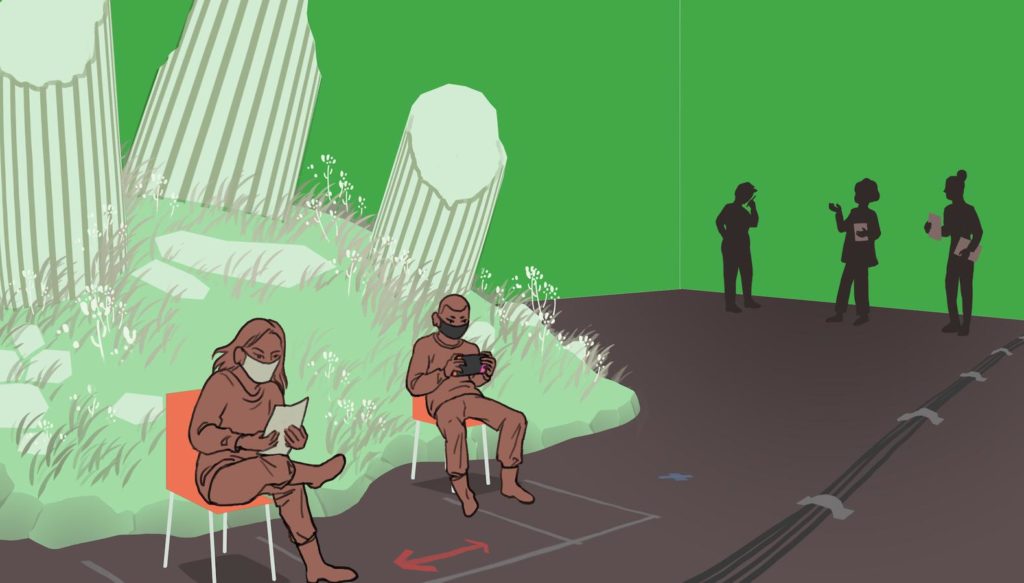
By Marci Liroff
I’ve been working on set as an Intimacy Coordinator for the last several months and I’ve been soaking up the atmosphere and learning so much.
It piqued my interest when the prop master came on to set with a gun and announced, “Gun on set!” Even though it was a rubber replica of a handgun, it was handled with the utmost safety. I’ve always been surprised that a prop master handles firearms. I spoke to Rebecca Kenyon (Moonlight, Cobra Kai, Dolly Parton’s Christmas on the Square, Council of Dads) to dig deeper into her job.
At what point do you get hired? Prop masters are typically brought in during prep a few weeks before principal photography. Usually hired by the production designer, we work in conjunction with the art department, prod designer and set decorator to make sure the props we’re bringing match the chosen look for the project.
In pre-production, I typically start with the organizational aspect of a project doing the breakdowns of the props, the graphics, and the specialty props. I collaborate with the director and designer to come up with visual references and make boards to further narrow down the look.
I like to open set. Opening set means being on set at or before call to supervise and establish props on set. I like to be there to answer any last minute questions, address any concerns or changes that might come up, and go over the day with my crew, help with the morning set-up and be there to answer any questions my crew, the director, cast or anyone has. Usually all choices have been made in advance, through the course of several meetings. This makes the shooting days much smoother and easier, so we don’t have to bother a busy director or producer on the day. During the course of prep we have several meetings including: the concept meeting, props meeting, props show and tell, production meeting, and any specialty meeting we think might require more specific attention. Examples of specialty meetings we’ve held recently include: the toilet meeting where we discussed how to portray fixing a toilet on screen, a drug meeting where I demonstrated some various tactics for consuming fake drugs, and meetings about boat work.
What items on set are you in charge of? A prop is anything an actor touches. While we don’t do furniture, we are in charge of paperwork, weapons, food, glasses, watches, anything someone touches.
What are some items you are responsible for that people would be surprised to know?
People are always surprised by the weird and random things the props department does (wedding rings, watches, eyeglasses).
We get to do weird and exciting things that people don’t even know exist. We create the stunt props like rubber weapons, foam bricks, and retractable knives. I even made a silicone spike bracelet for a character on Cobra Kai to drag across another character’s face.
What can an actor do to help your job? What do actors do that drive you crazy? Understanding the departments is a huge help. It is not impossible, but it definitely can be difficult to accommodate all last minute actor requests. Sometimes there can be a stroke of genius or something can come up out of nowhere, and we’re glad to help.
How are guns handled on a set?
I have taken some basic weapons training courses, but most of my training came during experience with others who have more training and experience. Sometimes I work with armorers. A licensed armorer is someone with the proper credentials to handle weapons and ensure the safety of everyone on set. They are used for any specific weapons or firearms handling and are licensed and proficient with many varieties. Armorers help the director and props department make choices best suited for each project.
What is the protocol for bringing a gun on set? It differs on a case by case basis, but the essentials are mostly the same. Guns should always be brought to set by the armorer, or props dept in a secured, lockable compartment. Who actually brings the firearm to set depends on the local laws and restrictions as well as the comfort and knowledge of the prop master. If there is anything that requires specific skills or licenses, an armorer is needed. It’s often a good choice to bring an armorer in because the prop master doesn’t always get to be around on set. There are plans to be made, meetings, shopping, ordering and always a lot of paperwork.
The guns should be carried to set and first shown to the first assistant director, then the gun is offered to be shown as fully empty and safe to any other members of the crew. The prop master or armorer calls, “Rubber gun on set.” Rubber, foam, and resin guns are all used on set to achieve the look of the firearm without the real thing.
“Cold weapon on set” meaning the AD and any concerned parties have seen and acknowledge that the firearm is empty and safe.
Then the gun is presented to all actors in the scene – especially the one who holds the weapon and anyone it may be pointed at. That would be the protocol for a non-firing weapon on set. All guns used are modified to fire blanks only. In the case of firing of a blank in the scene, the armorer will observe the rehearsals and determine the concerns and needs of the director to help accomplish the scene safely.
(Unfortunately, even with all the safety and precaution accidents can still happen. In 1984, actor Jon-Erik Hexum was a 26-year-old actor and had been filming a scene on a tv show called Cover Up.
Hexum grew increasingly frustrated with delays to filming the scene and began playing with the gun, spinning the barrel like a game of Russian roulette. He playfully spun the barrel, which had one bullet inside, and placed the gun to the temple of his head and pulled the trigger. The gun discharged a wad of paper which shattered his skull. He was put on life support and ultimately died due to his injuries
In 1993, actor Brandon Lee was shot dead in a scene gone wrong on the set the film, The Crow, when his costar fired a prop gun that had a dummy bullet lodged in its chamber).
Actors are always spoken to before participating in gunfire. We will usually ask if the actor has any training or experience with weapons and I encourage everyone to be as honest as possible. Its ok if you haven’t shot a gun. You won’t be able to say that by day’s end. Often times we do practice or test fire with anyone who would like it. We want everyone to be as safe and comfortable as possible.
Make sure to check out my online course “How To Audition For Film and Television: Audition Bootcamp”. You can view it on your laptop or your mobile device and your subscription gives you lifetime viewing privileges for this course. I’ll be adding lectures throughout the year.
Warning: I grant permission to share my blog as written with no additions or deletions. Posting my blog is in no way an endorsement of another site unless you obtain my written consent.





Recent Comments